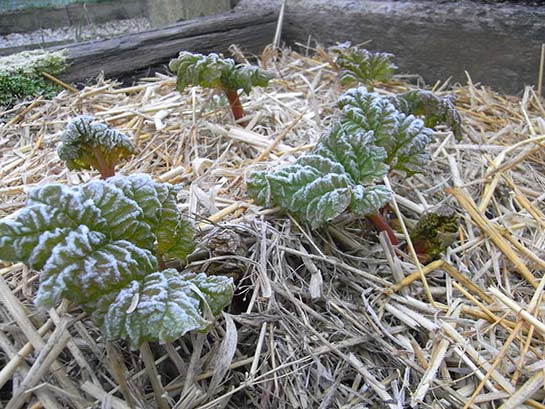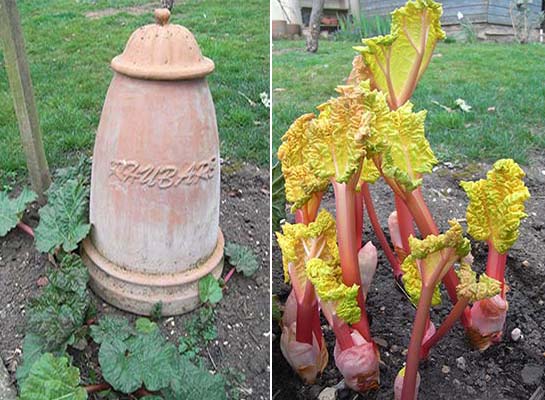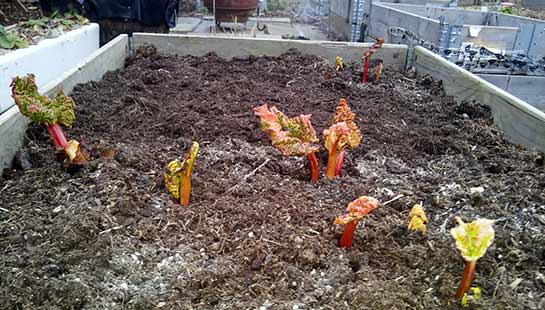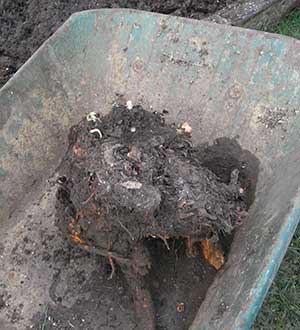Rhubarb is actually a fruit but it is widely regarded by gardeners as a vegetable. I have grown rhubarb in my garden for as long as I can remember and I have fond memories of pulling young stems of rhubarb in my parent’s garden as a child, dipping it into a bag of sugar to sweeten it before eating it raw.
After reading this page you will have learned how to grow rhubarb, but to be honest, it’s not difficult and even a neglected rhubarb plant can still produce a fair crop providing it is planted in a position with reasonable drainage and a little sunlight.
Rhubarb contains oxalic acid which is in fact a poison. If rhubarb was introduced in the UK for the first time today, I am sure it wouldn’t be allowed! The leaves contain the most oxalic acid and should never be eaten but the level in the stalks also increases later on in the season so my grandfather used to say I should never eat rhubarb after the end of June which also gives the plant a rest.
Plant: Late autumn or early winter with 50 – 75cm between plants. Put the root or crown in the ground with the buds just below the level of the soil. Firm down the soil and mulch with compost. Do not pick any stalks in the first year and remove any flower buts. Rhubarb needs the temperature to drop below 5 C over the winter in order for it to start to grow.
Harvest: Do not harvest in the first year and never take more than half of the stalks in from a crown. It can be harvested in the spring up until the beginning of June. Never cut stalks (this will cause the crown to rot) always ‘pull’ stalks, giving them a slight twist to release them. They will come away cleanly from the crown.
Useful to Know: Mulch with an organic compost after the leaves have died back in the summer to suppress weeds and maintain moisture. If flowers appear in the spring, remove these as they bud.
Varieties to plant: Timperly Early or Early Champagne for an early crop, Fultons Strawberry Surprise or Mammoth Red for ornamental looks, Ace of Hearts for a compact plant and small gardens.
Rotation Class: Doesn’t require rotation but requires lifting and dividing ever 3-4 years when changing the moving it onto fresh ground can be beneficial.
A partially shaded location is perfect for growing rhubarb. It pays to prepare the soil before planting by digging in some well rotted organic manure. I like to use well rotted horse manure but spent mushroom compost or even rotted farm yard manure will work well. Farm yard manure has the advantage of being slightly more acidic which rhubarb tends to like.
My grandfather taught me how to grow rhubarb. Rhubarb can be grown from seed, but I have never done this since it is far quicker to plant a crown (a one year old plant) that will give you a head start. Crowns can be bought in packets from garden centres, but even better than this, is if you know of somebody who has a mature crown (5 or 6 years old), you can ask them whether you could divide one of their roots. Rhubarb needs dividing every 5 to 6 years so you are encouraging their root to regrow by splitting it. If you divide it into three or four pieces (cut it using a sharp spade), you can replant a piece or two for them, in exchange for the left over pieces!

Established rhubarb can be ‘forced’ to crop a little early by covering it with a bucket or special terracotta ‘rhubarb forcer’ found in garden centres. This should be placed over the buds in January and mulch should be heaped around the edges to keep the light out. By March you should have a small amount of long blanched tasty pink-red stems that are tall and sweet with little leaf growth.
If you force a plant, give it a rest for the next 2 seasons.

Another method of forcing Rhubarb that I learned from Rupert Stephenson was to build a couple of frames over the crown (the photo below shows frames made from recycled pallets).
In the first year fill one frame and both in the second year giving a total frame height of 18 inches. Use straw / spent compost or leaves which will later feed the tubers as it rots down. Manure should not be used since it will hold too much moisture and cause the stems to rot. Keep the frames topped up.

When picking, push your hand down to the bottom of the frames to the crown and pull the stems as you would normally taking extra care not to snap the stems (which can again cause rot to set in).

Rhubarb grows from the outside of its tuber so as it increases in size, the centre eventually dies off, leaving an almost doughnut shape. To keep it healthy, it should be divided every five to six years.
Split each mature plant into three or even four crowns using the edge of a clean, sharp spade. The pieces will not look like much but re-planting these into a well manured, free draining soil as detailed above will create new vigorous growth and further increase your rhubarb bed.
So there you have it! Easy? You now know how to grow rhubarb!
